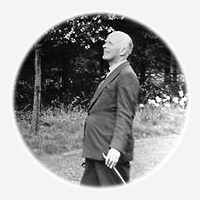Credit: Clive Nichols
History & National Collection
The arboretum is a historical living collection of trees from all over the world, some incredibly rare, some unusual and many ancient. Trees have featured strongly on the Thorp Perrow Estate since medieval times, evidence tells us that Springs wood – the heart of the arboretum – has been continued woodland since this time.
The 1840s were exciting times on the estate with the introduction of many trees from distant lands, over time adding to existing woodland, and forming what we now call the Pinetum. The planting continued with the arboretum starting in 1931, with the introduction of thousands of trees, again from across the world.
To date many of the original plantings still stand as giants, with many holding champion tree status with the Tree Registry. Thorp Perrow very proudly holds five national Collections with Plant Heritage who help to develop and preserve plants for the future.



History of Thorp Perrow
Sir Robert Ropner (1838 – 1924) emigrated to England from Germany in 1857 and founded the well-known fleet of merchant ships that carried the family House Flag for over 100 years. Thorp Perrow Estate was purchased by his Son, Sir William in 1927. Born in 1864, he was the third eldest of ten children.
Colonel Sir Leonard Ropner was 32 years old when the Estate was bought, and it was very soon afterwards that the planning and planting of the Arboretum began. It is not clear where this great love for trees came from – it was his son, Sir John’s joke that he should have collected French impressionist pictures but no such luck!
One of the nicest things about Thorp Perrow Arboretum is its slightly ‘amateurish’ atmosphere. It was, after all, designed and cared for by a man with no previous arboriculture experience – and this still remains the case to this day!
The Arboretum was Sir Leonard’s ‘Secret Garden’ and he was extremely proud of it, but towards the end of his life it had become neglected. Upon his death in 1977 his son, Sir John was faced with the problem of what to do with these 85 acres. Alan Mitchell (the famous dendrologist) was asked to come and advise, and when he re-emerged from the jungle he said in no uncertain terms, that the collection should be preserved at all costs.
Picking up the challenge, time, toil and teamwork has gone into making Thorp Perrow what you see today. Sir John and his wife, Niki, worked tirelessly, constantly improving and developing the Arboretum with a very hands-on approach. Sir Henry Ropner, his wife, Natasha and family are the current custodians, and continue the work of Sir John following his death in 2016.
We are so grateful to all our volunteers, members of staff, curators and family who have contributed so much over the years.
National Plant Collections
All trees in the Arboretum are labelled with a number on a plastic ‘luggage tag’ which is usually found on the trunk of the tree or around a lower bough. The green and black tags are often easier to spot from ‘inside’ the tree, particularly on large or low-growing trees. Feel free to leave the path and investigate the tree label, as long as it is safe to do so and you are not disturbing or trampling on any other plants or trees.
The entire collection is recorded in our catalogue, which can be purchased from the Tea Room for a small fee. If there is a particular tree you would like information on, please use the reference copy held in Tea Room.

Thorp Perrow is very proud to hold five National Plant Collections under the guidelines set out by the NCCPG. The ‘National Council for the Conservation of Plants and Gardens’ (N.C.C.P.G) now known as ‘Plant Heritage’ was founded as a registered charity in 1978 to combine the talents of botanists, horticulturalists and conservationists with the dedication of keen amateur and professional gardeners. Plant Heritage’s aims are to: encourage the propagation and conservation of cultivated plants in the British Isles; encourage and conduct research into cultivated plants, their origins, their historical and cultural importance and their environments; and encourage the education of the public in cultivated plant conservation.
We are guardians of these five fabulous collections:

Fraxinus (Ash)
No of species – 26
No of cultivars – 8
No of taxa – 44
Collection held since 1991
English name Ash tree, is a genus of flowering plants in the olive and lilac family, Oleaceae. It contains 45-65 species of usually medium to large trees, mostly deciduous though a few subtropical species are evergreen. The genus is widespread across much of Europe, Asia and North America.
Juglans (Walnut)
No of species – 6
No of cultivars – 6
No of taxa – 14
Collection held since 1991
English name Walnut tree, is a genus of 21 species in the family of Juglandaceae, the seeds of which are referred to as walnuts. All species are large deciduous trees. They are native species across the north temperature Old World from southeast Europe east to Japan, and more widely in the New World from southeast Canada west to California and south to Argentina.


Tilia (Lime)
No of species – 32
No of cultivars – 12
No of taxa – 44
Collection held since 1991
English name Lime tree, they are not related to the Lime fruit. Other names include Linden, and Basswood for the North American species. Tilia is a genus of about 30 species of trees native throughout most of the temperate Northern Hemisphere. The genus occurs in Europe and eastern North America, but the greatest species diversity is found in Asia. Under the Cronquist classification system, this genus was placed in the family Tiliaceae, but genetic research summarised by the Angiosperm Phylogeny Group has resulted in the incorporation of this genus, and of most of the previous family, into the Malvaceae family.
Laburnum
No of species – 4
No of cultivars – 12
No of taxa – 21
Collection held since 2001
English name Golden Chain Tree, is a genus of two species of small trees in the subfamily Faboideae of the pea family Fabaceae. They are native to the mountains of southern Europe from France to the Balkans.


Cotinus (Smoke Bush)
No of species – 2
No of cultivars – 15
No of taxa – 27
Collection held since 2002
English name Smoke tree or Smoke bush is a genus of two species of flowering plants in the family Anacardiaceae. Naïve to the warm temperate northern hemisphere.
Champion Trees
The Tree Register is a registered charity that was set up in 1988 by the late Alan Mitchell VMH and Victoria Schilling. The Tree Register gathers and records details of exceptionally large, historic, rare and remarkable trees growing in Britain and Ireland.
The unique tree register comprises of a computer database with details of more than 150,000 trees. Amongst the data gathered are recorded of the largest and tallest trees of each species, however it should be noted that all Champion Trees are huge!
Thorp Perrow is proud to hold 51 Champion Trees in the varied collection. It should be noted that 12 of these are held within some of the National Plant Collections.
Don’t miss these Champion Trees:
P71 – Betula medwediewii (Transcaucasian Birch). This tree was given Champion Tree status because it has the largest girth in the country, measuring 9m in height and with a bole measuring 0.4m. This wonderful multi-stemmed tree is location in Autumn Bay 2 and has fabulous Autumn colour. Thought to have been planted at Thorp Perrow in the 1930’s this tree was first introduced to the UK in 1897.
X162 – Laburnocytisus adamii. This tree is the largest and tallest in the country, measuring 7m in height and 132cm bole girth. Originated from a graft hybrid (Chimera) between Laburnum and Cytisus. The Laburnum forms the core of the tree and the influence of the Cytisus forms the outer skin of the tree. When in flower in May some branches bear yellow flowers of the Laburnum and some bear clusters of purple flowers from the Cytisus. In addition some branches will produce intermediate flowers of a coppery pink. It was introduced to this country by M Adam from Paris in 1825.

Leaving a Legacy
To commemorate a special occasion or a treasured family member or friend, many visitors choose to dedicate a tree, a seat or sponsor the planting of a wild flower area in the Arboretum.
Please contact us to find out how your generosity can bestow a lasting gift that will bring pleasure for generations to come.
Volunteering
Our wonderful team of volunteers support all the work we do in the Arboretum. They generously give their time and their skills to help us keep everything looking beautiful all year round for our visitors.
If you would like to spend more time outside surrounded by nature and a lovely team of like-minded people, please contact us to find out how you can join us.
